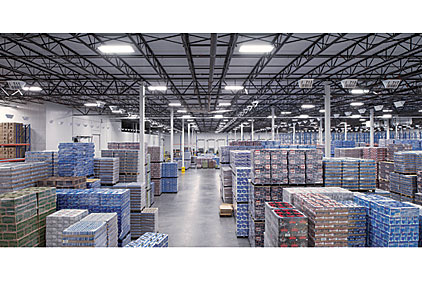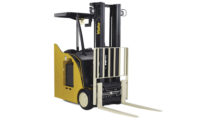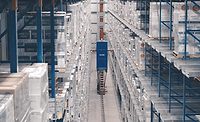Efficient beverage warehouse designs key to handling SKU proliferation
New facility designs offer opportunity to accommodate future growth

A trip to the local retail store can be an enlightening experience. Because of the considerable amount of SKU proliferation, a retail shelf might look quite different
|
from one month to the next. Taking this into account, an efficient warehouse might be more crucial than ever.
Chet Willey, owner of Arlington, Texas-based Chet Willey Associates and a design partner with HDA Architects, St. Louis, notes that the typical beverage distributor is adding an average of 100 different SKUs a year. “Everybody is adding new brands and packages, so that’s why [HDA] is so good with new facilities and adding onto current facilities, because of the additional SKUs that everybody’s adding throughout the U.S.,” Willey says.
Consolidation also has impacted the wholesale environment, experts note. Willey cites the combination of Miller Brewing Co. and Molson Coors Brewing Co. in the United States to form MillerCoors as an example.
Lloyd Snyder, senior vice president of Portland, Maine-based Woodard & Curran, adds that the dairy industry also has seen the effects of consolidation as facilities have been closed in order to reduce overall supply-chain costs.
Designing for efficiency
Whether because of the increasing number of SKUs or consolidation efforts, beverage plants want to ensure these factors are not hindering their operations. To ensure the facility is operating at its full potential, plant managers have a number of things they must consider.
“It is important to evaluate the impact of SKUs, volumes, product flow and frequency in evaluating the impact of products on warehouse efficiency,” Snyder says. “Systems to optimize picking efficiency and product layout can be developed when taking a holistic look at inputs.”
Among the ways plant managers can do this is by capitalizing on the space that they already have. For example, nested operations can optimize space, and multifunctional equipment can be used to accommodate multiple unit operations without the need for accumulation buffers, Snyder adds.
Another way facilities can better utilize space is through racking systems or designated pick areas. “Streamlining the pick area layout will improve your efficiency, and usually that’s done in conjunction with going to a more efficient way of picking,” Chet Willey Associates’ Willey says.
One of the more popular picking operations among beverage distributors is voice picking, Willey notes. When combined with a more efficient picking layout, voice picking can help wholesalers see productivity increases of 20-50 percent, Willey says.
Woodard & Curran’s Snyder also notes the importance of engineers and operators evaluating layouts to optimize flow. “It is important to reduce manning labor and reduce costs by allowing each operator to control multiple unit operations and provide the ability to replenish raw materials efficiently,” he says.
For example, Stamford, Conn.-based Nestlé Waters North America has designed a system in which it aligns palletizer and stretch wrapper equipment to allow a single forklift operator to handle multiple units while providing synergy to other drivers, Snyder explains.
“Greenfield” solutions
To overcome limitations associated with an existing facility, Chet Willey Associates’ Willey says the ideal solution when looking for optimum efficiency is going with a new layout or “greenfield” site.
“I work with [HDA] and we do the most efficient layout possible, and the building is worked to accommodate that so you don’t have the building restrictions that you deal with on a current facility,” he says. “That’s probably the biggest difference is we work together in a new facility, and we have the most optimum layout that you can possibly have when you’re building from the ground up.”
When developing a new warehouse, current sales data and volume can be crucial for calculating your current needs as well as your needs for the future. “When you build a warehouse expansion or a new warehouse, you have to base the calculations of the size of the facility on several things,” Willey says. “One, of course, is you [reference] the peak volume months, because you have to build a warehouse on your peak.”
When calculating optimum facility sizes, Willey and HDA will take the actual sales data and calculate what will be necessary for the peak months and extrapolate that on five- and 10-year projections. This allows HDA to show beverage distributors what their proposed facility options are based on mathematically calculated data, Willey explains.
Jack Holleran, president of HDA, adds that beverage wholesalers also should consider the following items when considering a “greenfield” facility: automation to handle increased SKUs, with the majority of volume touched only one time; LED lighting to replace high-bay fluorescent lighting to reduce utility costs; greater clear heights for increased storage; open office designs with collaborative areas; cross docking to accommodate fleet changes; and analysis of options to reduce operating costs, including building envelope, HVAC, electrical, water, solar and wind.
Woodard & Curran’s Snyder emphasizes the importance of consulting plant operators and managers when developing new facilities. “When designing a ‘greenfield’ facility, it is important that the correct design be evaluated by experienced operations personnel,” he says. “This team will be the people to operate the equipment. The defining characteristics of this team will drive design considerations and allow synergies to be established at startup for the long term.”
Looking for a reprint of this article?
From high-res PDFs to custom plaques, order your copy today!







